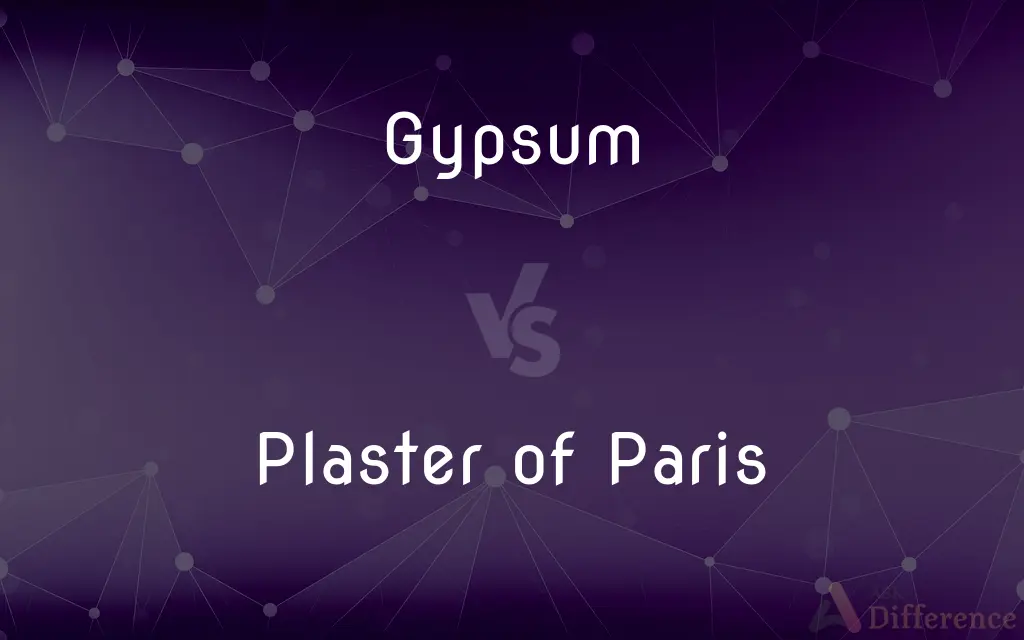Gypsum vs. Plaster of Paris — What's the Difference?
Edited by Tayyaba Rehman — By Fiza Rafique — Published on December 17, 2023
Gypsum is a naturally occurring mineral, while Plaster of Paris is the refined product made by heating gypsum to remove its water content.

Difference Between Gypsum and Plaster of Paris
Table of Contents
ADVERTISEMENT
Key Differences
Gypsum and Plaster of Paris are both commonly used materials, especially in the construction and arts sectors. Gypsum, in its essence, is a hydrated calcium sulfate mineral found in nature. Conversely, Plaster of Paris is created by processing and heating gypsum to eliminate a significant portion of its water content.
Within the realms of architecture and interior design, Gypsum often finds itself used in the form of wallboards or drywalls. These are essential components in modern construction. On the other hand, Plaster of Paris is typically used for decorative elements, moldings, and castings, owing to its ability to harden quickly and take on intricate forms.
Gypsum's significance can't be understated; it has been used since ancient times, even in constructing the pyramids of Egypt. Plaster of Paris, with its faster-setting properties, has historically been pivotal in making casts for broken bones, preserving the integrity of the fracture.
From an environmental standpoint, Gypsum is lauded for being eco-friendly. It can be recycled endlessly without any degradation in quality. In contrast, Plaster of Paris, given its derived nature, requires more energy-intensive processes for its production.
The purity and consistency of Gypsum make it a staple in agriculture as well, where it's used as a soil conditioner. Meanwhile, artists and craftsmen frequently lean on Plaster of Paris for sculptures, given its ability to capture fine details and dry into a hard, smooth surface.
ADVERTISEMENT
Comparison Chart
Definition
Natural mineral.
Refined product of gypsum.
Use
Construction (drywall), agriculture.
Decorative arts, medical casts, sculptures.
Composition
Hydrated calcium sulfate.
Partially dehydrated gypsum.
Setting Time
Takes longer to set.
Sets quickly.
Application
Wallboards, soil conditioner.
Molds, casts, and intricate designs.
Compare with Definitions
Gypsum
Gypsum is a soft sulfate mineral composed of calcium sulfate dihydrate.
The Gypsum wallboard is common in most modern homes.
Plaster of Paris
Plaster of Paris is a white powder that hardens when moistened and allowed to dry.
She used Plaster of Paris to create a mold of her hand.
Gypsum
Gypsum is a primary ingredient in drywall.
When renovating, they replaced the damaged Gypsum boards.
Plaster of Paris
Plaster of Paris is derived from gypsum and is used in casting and molding.
The artist chose Plaster of Paris for his sculpture due to its fine detail capture.
Gypsum
Gypsum has been used since ancient times for construction purposes.
The pyramids of Egypt have evidence of Gypsum usage.
Plaster of Paris
Plaster of Paris is often used for creating decorative architectural elements.
The intricate ceiling medallions were made of Plaster of Paris.
Gypsum
Gypsum can be found in sedimentary rock formations.
Large Gypsum deposits were found in the desert areas.
Plaster of Paris
Plaster of Paris sets quickly, making it ideal for art and craft projects.
Children enjoyed using Plaster of Paris to make their art pieces.
Gypsum
Gypsum acts as a soil conditioner in agriculture.
Farmers use Gypsum to improve soil structure.
Plaster of Paris
Plaster of Paris has been historically used for medical casts.
The broken arm was encased in a Plaster of Paris cast for healing.
Gypsum
A widespread colorless, white, or yellowish mineral, CaSO4·2H2O, used in the manufacture of plaster of Paris, various plaster products, and fertilizers.
Gypsum
A mineral consisting of hydrated calcium sulphate. When calcinated, it forms plaster of Paris.
Gypsum
A mineral consisting of the hydrous sulphate of lime (calcium). When calcined, it forms plaster of Paris. Selenite is a transparent, crystalline variety; alabaster, a fine, white, massive variety.
Gypsum
A common white or colorless mineral (hydrated calcium sulphate) used to make cements and plasters (especially plaster of Paris)
Common Curiosities
Why is Gypsum considered eco-friendly?
Gypsum can be recycled indefinitely without degrading its quality.
What is Gypsum primarily used for?
Gypsum is mainly used in construction, particularly in drywall and plasterboard.
Can Gypsum be found naturally?
Yes, Gypsum is a naturally occurring mineral found in sedimentary rock formations.
How is Plaster of Paris different from Gypsum?
Plaster of Paris is made by heating Gypsum to remove its water content, making it set quickly when mixed with water.
Is Plaster of Paris safe for crafts with children?
Yes, but it's essential to ensure children don't ingest it and to supervise their activities.
What's the primary advantage of using Plaster of Paris in arts?
It captures fine details and dries to a hard, smooth surface, making it ideal for sculptures and molds.
How quickly does Plaster of Paris set?
It can set in a matter of minutes to hours, depending on the mixture and conditions.
Can Gypsum be used in agriculture?
Yes, Gypsum is used as a soil conditioner to improve soil structure.
Can Gypsum boards be used in damp areas?
While Gypsum boards can handle some moisture, it's better to use moisture-resistant versions in damp areas.
Share Your Discovery

Previous Comparison
LCD TV vs. Plasma TV
Next Comparison
Kurta vs. KurtiAuthor Spotlight
Written by
Fiza RafiqueFiza Rafique is a skilled content writer at AskDifference.com, where she meticulously refines and enhances written pieces. Drawing from her vast editorial expertise, Fiza ensures clarity, accuracy, and precision in every article. Passionate about language, she continually seeks to elevate the quality of content for readers worldwide.
Edited by
Tayyaba RehmanTayyaba Rehman is a distinguished writer, currently serving as a primary contributor to askdifference.com. As a researcher in semantics and etymology, Tayyaba's passion for the complexity of languages and their distinctions has found a perfect home on the platform. Tayyaba delves into the intricacies of language, distinguishing between commonly confused words and phrases, thereby providing clarity for readers worldwide.
















































